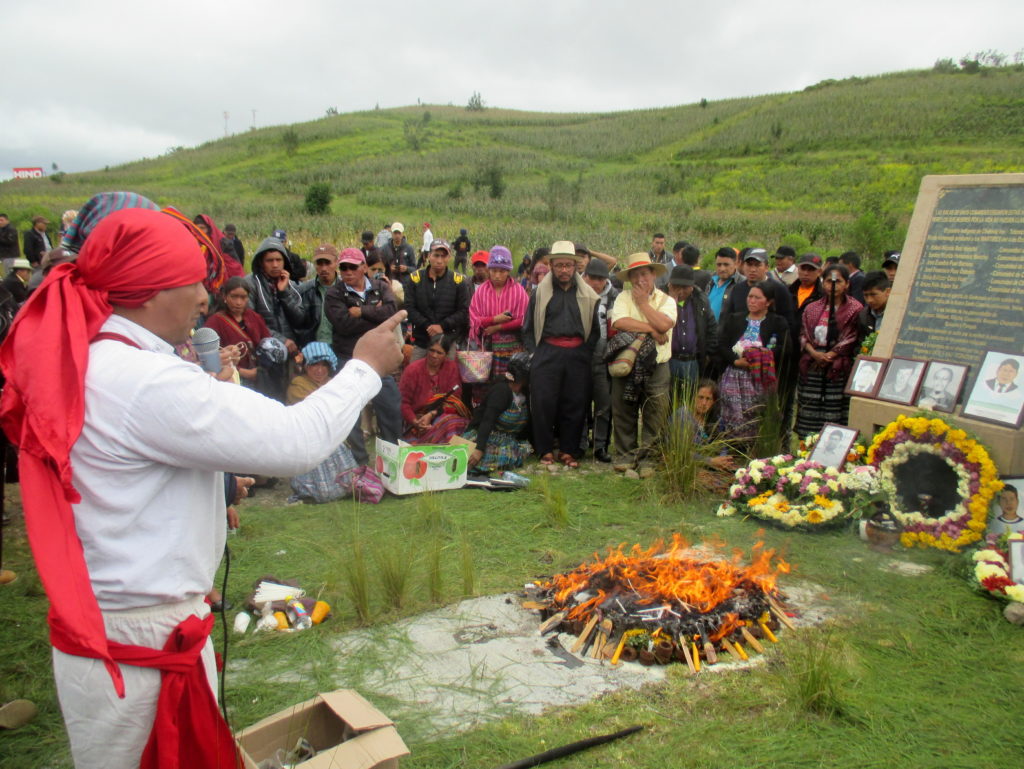
María Francisca García’s children were bundled up. At nearly 10,000 feet above sea level, the bitter wind and biting sun were unforgiving. The family was waiting for a midday ceremony to begin at the Cumbre de Alaska, a high point along the Pan-American highway up in the western highlands of Guatemala, 105 miles west of the capital.
García’s two daughters never really knew their father, Santos Nicolás Hernández. Less than a year apart, they were both babies when he was killed right here along the highway, when soldiers opened fire on indigenous protesters on October 4, 2012. Six men were shot and killed, and a seventh died in the hospital shortly after as a result of injuries sustained that day. Dozens more were wounded.
Now six and seven years old, the daughters of García and Hernández attended a ceremony with their mother to mark the anniversary of the massacre. The traditional indigenous Maya Kiche authorities of the 48 Cantones of Totonicapán arranged and attended the ceremony held at the massacre site, located at the border between the Totonicapán and Sololá departments.
“I am glad because all of the authorities of the 48 Cantones are still supporting us. They have not left us alone,” García told Toward Freedom.
García and her children attended the ceremony along with several other widows and relatives of the massacre victims. Several of those who had been wounded were also present. García hopes for justice, but she is not sure that will come to pass.
“The truth is I say yes [I hope for justice], but no one knows. No one knows,” said García. She also hopes the anniversary commemorations and support continue. “I hope they keep doing what they’re doing now and that they continue supporting us. That’s the most important thing to me.”
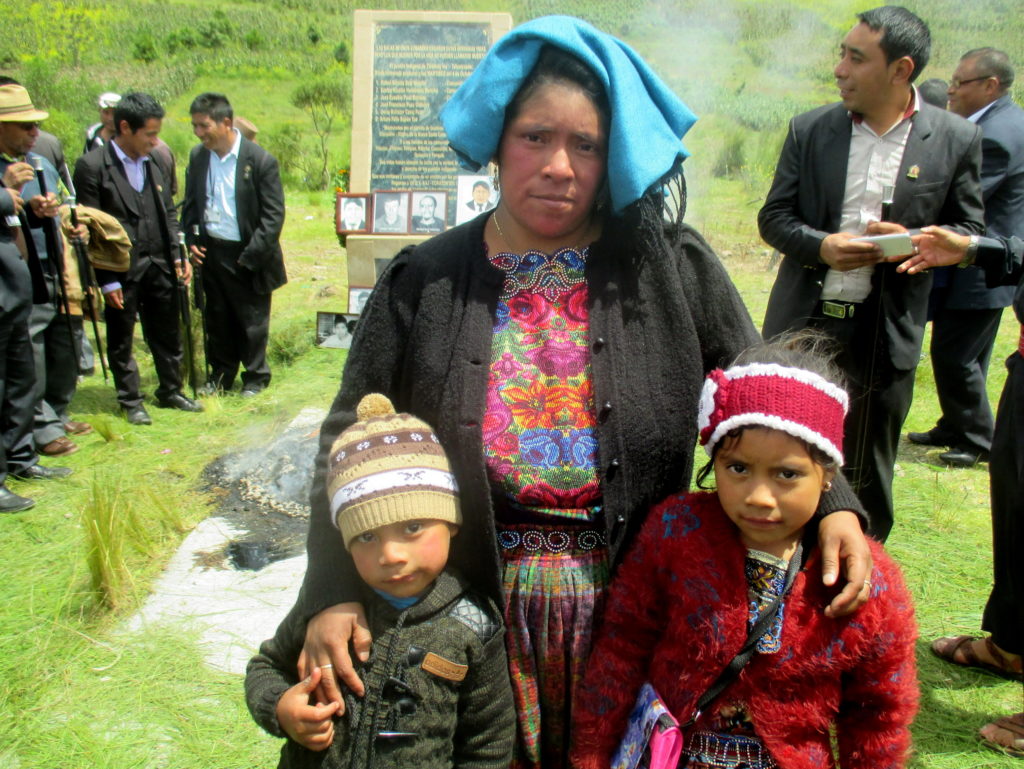
Indigenous massacre survivors and relatives of victims are keeping the struggle for memory and justice alive in Guatemala. The October 4, 2012 massacre was the first and only massacre of indigenous people by soldiers following the 1996 Peace Accords that ended a 36-year armed conflict. This year’s commemoration of the sixth anniversary of the 2012 massacre took place a week after a tribunal confirmed state armed forces committed genocide in the early 1980s.
Following the CIA-backed overthrow of progressive Guatemalan president Jacobo Arbenz in a 1954 military coup, leftist guerrilla forces began taking up arms against successive military and authoritarian rulers. Over the course of the 1960-1996 armed conflict, an estimated 200,000 people were killed and another 45,000 people were forcibly disappeared. More than 80 percent of victims were indigenous Maya civilians, and the perpetrator in the overwhelming majority of cases was the military.
In the 1990s, a UN-backed truth commission determined that state forces had carried out acts of genocide in four regions of the country during the conflict. One of those areas was the Maya Ixil region in the northern part of the Quiché department, 130 miles northwest of the capital. Soldiers, special forces, and paramilitary forces killed thousands of local Maya Ixil civilians and razed entire villages to the ground. The military bombed some villages. State forces raped women and killed their infants and children.
Two courts have now concurred with the truth commission’s determination that genocide occurred in the Ixil region under General Efraín Ríos Montt, a military dictator who ruled from March 1982 to August 1983. In March 2013, Ríos Montt was convicted of genocide and crimes against humanity. His former head of military intelligence José Mauricio Rodríguez Sánchez was acquitted, but Ríos Montt was sentenced to 80 years in prison.
The verdict and sentence were quickly overturned, and a court reset the trial to a much earlier stage in proceedings. In the meantime, Ríos Montt was deemed unfit for prison and then died in April 2018. The partial retrial against Rodríguez Sánchez continued.
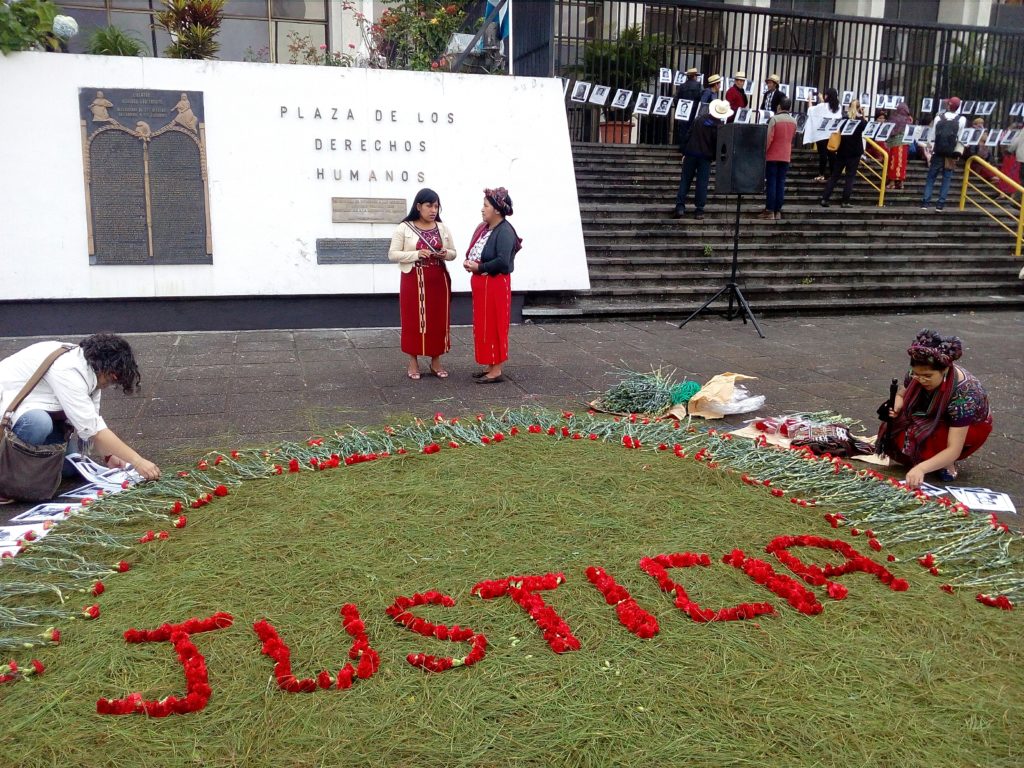
The 15th floor courtroom in the Guatemala City court complex was packed on September 7 for one of the final hearings in the trial of Rodríguez Sánchez for genocide. Maya Ixil genocide survivors and relatives of victims had joint plaintiff standing alongside the Office of the Public Prosecutor. The survivors’ lawyers wore the red and black traditional men’s jackets from Nebaj, one of the three main towns in the Ixil region. They did so at their clients’ request, to honor the victims of genocide.
“At a certain point, the army considered 100 percent of the Ixil to be guerrilla sympathizers, and with that, they converted them into the internal enemy,” Edgar Pérez, one of the lawyers for the survivors and victims, told the court during the September 7 proceedings.
“The massacres were indiscriminate,” he said during the hearing. “The intention was to destroy that group.”
The three judges hearing the case agreed with Pérez. On September 26, they unanimously ruled that genocide occurred during Ríos Montt’s rule. The framework behind the genocide was manifold, they determined. It involved not only the internal armed conflict and a national security doctrine, but also the protection of US interests, they explained in the verdict. However, in a split decision, they found Rodríguez Sánchez not guilty of genocide and crimes against humanity.
Around the country, survivors of genocide, massacres, sexual violence, and other crimes committed against civilians by state forces during the armed conflict continue to organize and push for justice. Up in the highlands of Totonicapán, the indigenous authorities of the 48 Cantones and the widows and survivors of the October 4, 2012 massacre are doing the same.
Six years ago, thousands of indigenous community members set up several highway blockades to protest energy price hikes, and to push for the government to respond to demands concerning education, services, and constitutional reform. It was the first year of the administration of president Otto Pérez Molina, a former military special forces and intelligence officer who was active in the Ixil region during Ríos Montt’s rule. Before his term was up, Pérez Molina, his vice president, and many other high-level officials were arrested and jailed for corruption.
Back in October 2012, the Pérez Molina government deployed both police and soldiers to the area of the highway blockades. Police kept their distance, but a contingent of 89 soldiers approached the blockade at the Cumbre de Alaska, at kilometer 169 (mile 105) of the Pan-American highway and got out of their military trucks to confront the unarmed indigenous protesters. According to reports, they were met with rocks thrown their way. Soldiers opened fire indiscriminately, killing six and wounding dozens.
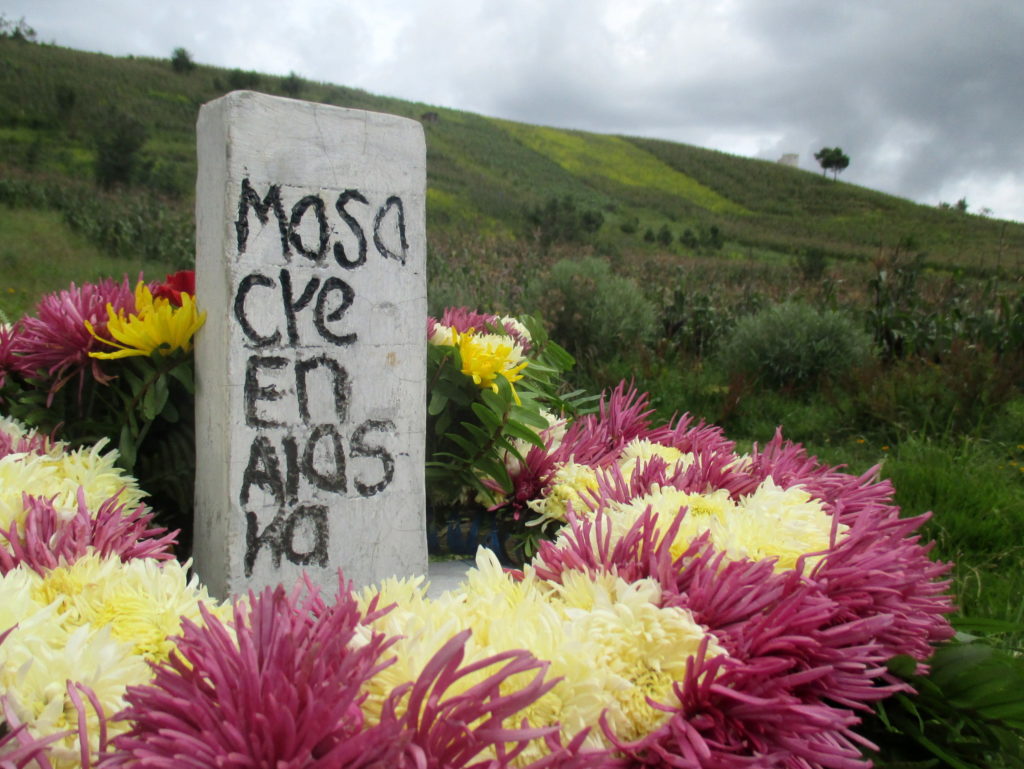
No one was expecting that to happen in 2012, said Eduardo Juan Yax, president of the indigenous authorities of the 48 Cantones of Totonicapán.
“The characteristic of the 48 Cantones has always been to go out and protest when their needs are not being met. But a situation like that had never happened, taking into account that we’re in an era of peace in theory and in a quote unquote democracy,” Yax told Toward Freedom.
Within days of the massacre, the colonel who headed the contingent, Juan Chiroy, and seven other soldiers were arrested. Six years later, their trial is still not underway. They were originally charged with homicide and attempted homicide under an altered emotional state, but the prosecution pushed for charges of extrajudicial execution and attempted extrajudicial execution. A judge accepted those charges in 2015, but the issues was tied up in legal motions until January 2018, when a higher court ruled in favor of the extrajudicial execution charges. A date has not yet been set for the trial to continue.
The government had initially claimed that the deaths were the result of an exchange of gunfire between soldiers and protesters. The official version later became that the Ministry of the Interior coordinating the police and army operations that day had ordered state forces to keep their distance and not engage. Chiroy ignored those orders, according to the official version, but Yax and other indigenous authorities don’t buy it.
“We don’t think it was disobedience. First of all, there was coordination with the national police force and they had not attacked, so there was more or less an understanding in [the Ministry of the Interior] to safeguard the security of all of the participants,” said Yax.
Yax thinks the fact that the protest blockades continued into the afternoon, prolonging the standstill of commercial traffic, may have played a role in the government response. He also firmly believes the fact that it was Pérez Molina in power drastically influenced the situation, given the then president’s involvement in the internal armed conflict.
“We believe, and we are sure we are not wrong, that the president was the one to give the order for Colonel Chiroy to attack. So that is not disobedience. That is extrajudicial execution,” said Yax.
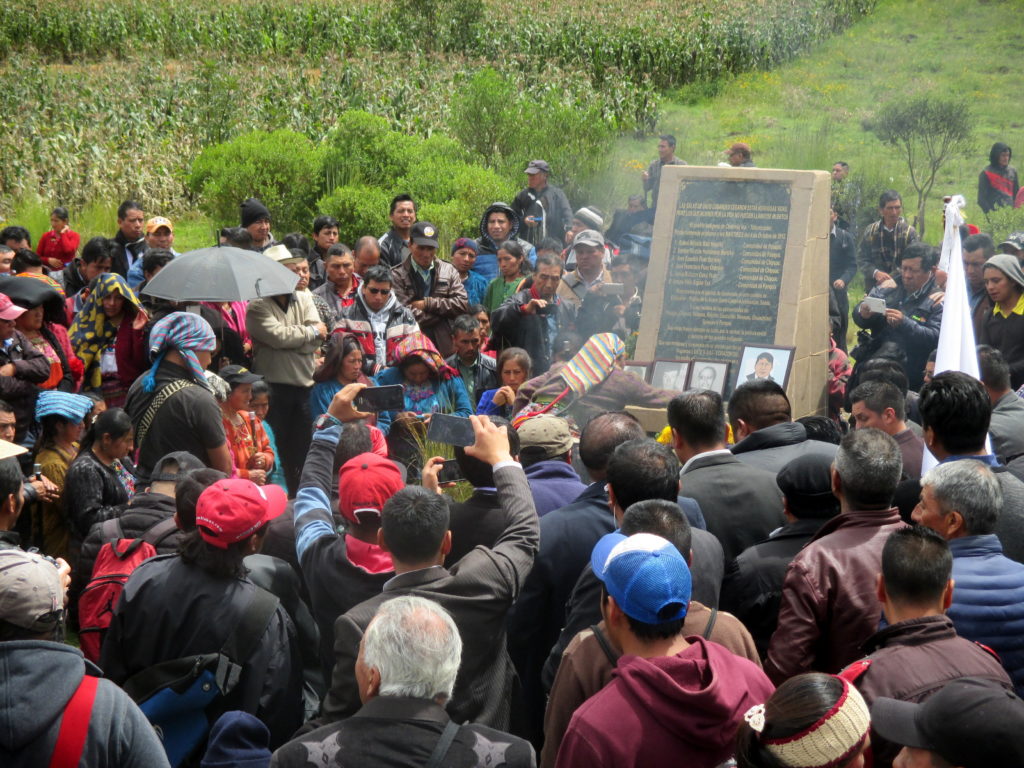
Yax and several other indigenous authorities spoke at the ceremony commemorating the sixth anniversary of the October 4, 2012 massacre, honoring the memory of each of the victims. Santos Nicolás Hernández Menchú. José Eusebio Puac Barreno. Rafael Nicolás Batz Menchú. Jesús Baltazar Caxaj Puac. Arturo Félix Sapón Yax. Jesús Francisco Puac Ordóñez. Domingo Pascual Solís.
“The goal is to remember them and to leave a legacy for our future generations who will struggle for the defense of our rights,” said Yax.
The ceremony was in Kiche, but certain words in Spanish popped out during the ceremony and remarks by indigenous authorities and relatives of the victims. Otto Pérez Molina. Army. Jail. Souls. Orphans. Blatantly. Intention. Galil. 0.55 Caliber. Protest. Rights. But one word in particular kept coming up in Spanish over and over. Justice. Justice. Justice. Justice. Justice. Justice. Justice. Justice.
Sandra Cuffe is a freelance journalist based in Central America. You can find her on twitter at @sandra_cuffe or read more of her work at sandracuffe.com.
